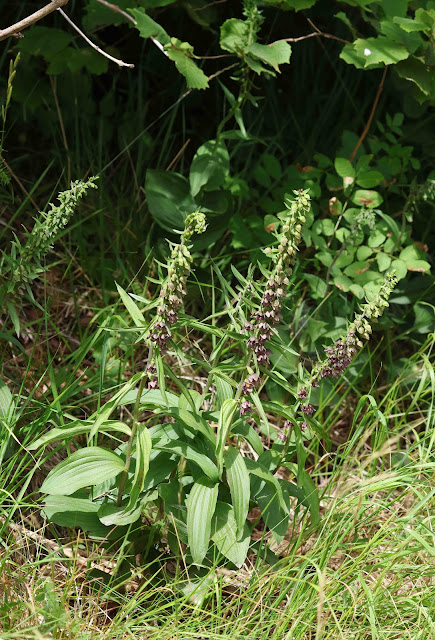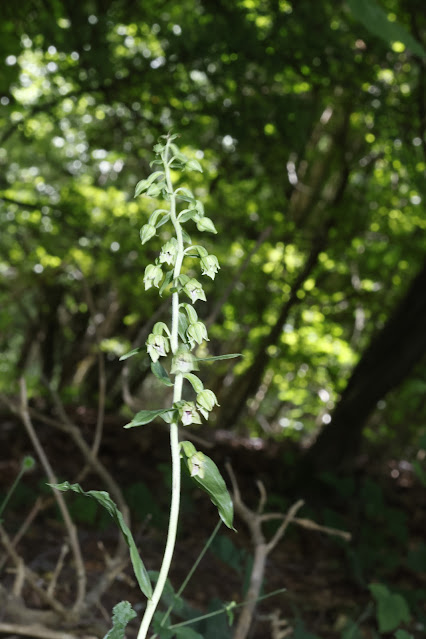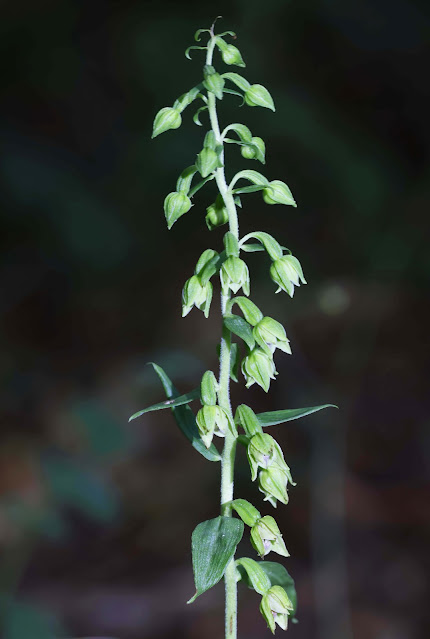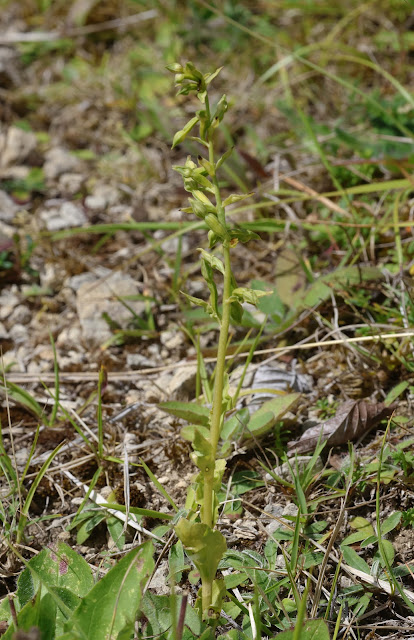Our first stop was at an unremarkable bank that lay below a hedge beside a road, this being a not untypical habitat of Broad leaved Helleborines, and here a number of them grew, those in the sunniest spots, which this helleborine prefers, being in full flower but most others were in shadier areas, remaining green and would not achieve the deep purplish red coloured flowers of those in the sunshine.
They are robust plants and can grow up to a metre in height, certainly taller than the ones we viewed today which themselves were impressive, well as far as helleborines are concerned. They are uncommon but not rare and are widely distributed throughout England, Wales and central Scotland and are found thoughout Europe right across to China and even in North Africa
Although primarily an orchid of ancient woods, in the city of Glasgow they have showed a preference for and successfully colonised suburban areas. Seventy five percent of colonies there are in parks cemeteries, golf courses, gardens, railway embankments and roadsides. There is no rational explanation as to why this has uniquely occurred in Glasgow and no other city in Britain These plants tend to be the largest and possess the greatest capacity to produce flowers which can number anywhere from 15-50 on one plant.
The flowers are visited by a number of insects but chiefly Hymenoptera of which the Common Wasp is a member and one of the most frequent pollinators, becoming intoxicated on the potent nectar and not unreasonably, like any drunk keeps coming back to the flowers for more which guarantees the flowers have the greatest chance of being pollinated.
It has also been suggested that its presence in woodland is an indicator of the presence of truffles but apparently this is not infallible and could even be an urban myth.
Having paid our respects we moved on by taking a track uphill away from the road and that ran alongside and through beech woodland, where we found more emergent Broad leaved Helleborines and a White Helleborine, now done with flowering and setting seed.
Our next helleborine target was the nationally scarce Narrow lipped Helleborine which prefers to grow in the deep shade of mature woodland.The ones we viewed today were in typical habitat on a steep chalk bank shaded by mature beech trees. Last time we visited, there were only two plants and another one that had been nibbled by deer but this year there were at least seven growing, one of which was an impressive 40cm tall and in flower.
This helleborine is not a showy brightly coloured orchid but more one for the connoisseur, the flowers, of which there can be up to twenty five but in this case nineteen, are individually held by a thin stalk from the main stem, the flowers hanging down like miniature bells and appearing hardly open but if regarded from below are revealed to be violaceous pink with a maroon centre enclosed within a hood of green sepals
It was hard to drag myself away from these helleborines that for me possessed a charm all of their own, their scarcity, subtle beauty and tenuous existence on this precipitous bank, prone to the whims of weather and deer combining to create an overall allure and concern about their vulnerability.Everywhere these days more and more of our flora and fauna seem to be just hanging on in increasingly small pockets of natural habitat that have either escaped notice or have to be protected in one way or another. It is not a happy situation but all one can do is make the best of it and enjoy and appreciate such as these helleborines while they remain.
Carrying on upwards on the track we left the shade of the wood behind and found ourselves out in the open on the sun warmed slopes of calcareous downland. Here in a small depression lurked our final helleborine and like the Green flowered Helleborine it is classed as nationally scarce and is on the decline in the southern part of its distribution in England. It has a restricted distribution outside of Britain being found in Andorra, France, Belgium, Germany, Ireland, Spain, Portugal, Denmark and Sweden.
If I thought the previous helleborine was unremarkable then the half dozen Green flowered Helleborines that grew here in their little concave suntrap took it to another level of unassuming inconspicuity.
Initially I found it hard to discern their overall yellowish green appearance against a background of chalk rubble and thin grass.The tallest was no more than 14cm in height although they can grow up to 40cm in more agreeable habitat.
The disproportionately small flowers which seldom open wide look similarly green to the rest of the plant.The half dozen plants we saw today had maybe a little way to go yet before the flowers opened, the buds appearing to be still firmly closed. The flowers do not require insects to pollinate them as they self pollinate before the buds open which may explain why they are so insignificant.




















No comments:
Post a Comment